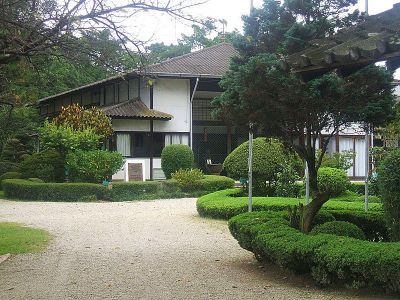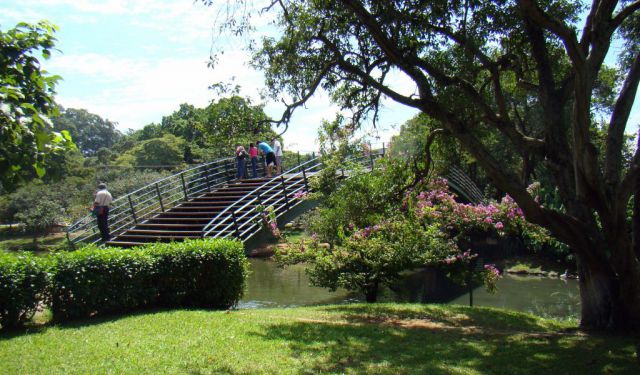
Pavilhao Japones (Japanese Garden), Sao Paulo
If you wish to relax after a hard day's work or a tough workout in the park, but, at the same time, would like to experience something exotic and different, the Pavilhão Japonês (Japanese Garden) is an ideal place for that. A symbol of friendship between Brazil and Japan, the garden is known as the "jewel of the Ibirapuera Park", and is spread over 7500 square meters, encompassing an abundance of plants (including bonsai trees), ponds and small lakes, filled with goldfish as well as Shoin-style buildings, and offering a glimpse into the Japanese culture.
The peculiarity of this park is in the fact that it was originally built in Japan, then taken apart, piece by piece, and reassembled in Sao Paulo in 1954, delivered as a gift for the fourth centenary of the city's foundation. The original Japanese materials - wood, volcanic rock, and Kyoto mud - of which the buildings and the garden have been made, facilitate a better cultural perception and entourage.
The garden's central building, created by Sutemi Horiguti, a professor at the University of Tokyo, is a replica of the Katsura Palace, the former summer residence of the Emperor in Kyoto, Japan, built between 1620 and 1624. It is divided into a hall and several adjoining rooms that house a display of samurai clothes, pottery, ceramics, costumes, and sculptures from several Japanese imperial dynasties. Upstairs is the Tea Room, known as chashitsu, used for traditional tea ceremonies.
The peculiarity of this park is in the fact that it was originally built in Japan, then taken apart, piece by piece, and reassembled in Sao Paulo in 1954, delivered as a gift for the fourth centenary of the city's foundation. The original Japanese materials - wood, volcanic rock, and Kyoto mud - of which the buildings and the garden have been made, facilitate a better cultural perception and entourage.
The garden's central building, created by Sutemi Horiguti, a professor at the University of Tokyo, is a replica of the Katsura Palace, the former summer residence of the Emperor in Kyoto, Japan, built between 1620 and 1624. It is divided into a hall and several adjoining rooms that house a display of samurai clothes, pottery, ceramics, costumes, and sculptures from several Japanese imperial dynasties. Upstairs is the Tea Room, known as chashitsu, used for traditional tea ceremonies.
Want to visit this sight? Check out these Self-Guided Walking Tours in Sao Paulo. Alternatively, you can download the mobile app "GPSmyCity: Walks in 1K+ Cities" from Apple App Store or Google Play Store. The app turns your mobile device to a personal tour guide and it works offline, so no data plan is needed when traveling abroad.
Pavilhao Japones (Japanese Garden) on Map
Sight Name: Pavilhao Japones (Japanese Garden)
Sight Location: Sao Paulo, Brazil (See walking tours in Sao Paulo)
Sight Type: Attraction/Landmark
Guide(s) Containing This Sight:
Sight Location: Sao Paulo, Brazil (See walking tours in Sao Paulo)
Sight Type: Attraction/Landmark
Guide(s) Containing This Sight:
Walking Tours in Sao Paulo, Brazil
Create Your Own Walk in Sao Paulo
Creating your own self-guided walk in Sao Paulo is easy and fun. Choose the city attractions that you want to see and a walk route map will be created just for you. You can even set your hotel as the start point of the walk.
Japantown Walking Tour
Home to the world's largest ethnic Japanese community outside Japan, the Sao Paulo district of Liberdade entices tourists with its Asian-inspired influences present everywhere: restaurants, shops, decor, markets, etc.
Up until the late 19th century, the area was known as Campo da Forca (Field of the Gallows) as the one reserved for the execution of slaves and convicts – for whom the only... view more
Tour Duration: 1 Hour(s)
Travel Distance: 0.8 Km or 0.5 Miles
Up until the late 19th century, the area was known as Campo da Forca (Field of the Gallows) as the one reserved for the execution of slaves and convicts – for whom the only... view more
Tour Duration: 1 Hour(s)
Travel Distance: 0.8 Km or 0.5 Miles
Ibirapuera Park Walking Tour
Located in the very heart of Sao Paulo, Ibirapuera Park is the city's most famous attraction. The park was designed by architect Oscar Niemeyer together with landscapist Roberto Burle Marx. It opened to the public on the 21st August, 1954. With a total space of 2 million square meters, the park features a beautiful landscape, filled with lakes, fountains, monuments, theaters, playgrounds,... view more
Tour Duration: 2 Hour(s)
Travel Distance: 3.9 Km or 2.4 Miles
Tour Duration: 2 Hour(s)
Travel Distance: 3.9 Km or 2.4 Miles
Paulista Avenue Walking Tour
One of the main arteries of Sao Paulo, Paulista Avenue is a famous location and a symbol of the city's economic and political power. On both sides the avenue is lined with impressive high-rising architecture, extensive shopping areas, and cultural institutions.
The history of skyscrapers in Sao Paulo started in the late 1930s with the first multi-story edifice constructed at the corner of... view more
Tour Duration: 1 Hour(s)
Travel Distance: 2.1 Km or 1.3 Miles
The history of skyscrapers in Sao Paulo started in the late 1930s with the first multi-story edifice constructed at the corner of... view more
Tour Duration: 1 Hour(s)
Travel Distance: 2.1 Km or 1.3 Miles
Sao Paulo Introduction Walking Tour
São Paulo is a bustling metropolis city. It is the most populous city in Brazil and the largest Portuguese-speaking city in the world. It is also the largest city in the Southern Hemisphere and one of the largest megapolis in the world. Portuguese Jesuit missionaries founded the city in 1554 on the anniversary of the conversion of St. Paul and named the city after him.
São Paulo became an... view more
Tour Duration: 1 Hour(s)
Travel Distance: 2.5 Km or 1.6 Miles
São Paulo became an... view more
Tour Duration: 1 Hour(s)
Travel Distance: 2.5 Km or 1.6 Miles




